In 66 BC, the populist senator Catiline conspired to violently overthrow the government and enact populist reforms, but Cicero discovered the conspiracy and a bloody aftermath followed. The populares were discredited
As a result, Pompeius, Crassus and Julius Caesar created a private alliance known now as the First Triumvirate. With their backing, Julius Caesar was elected to the consulship in 59 BC.
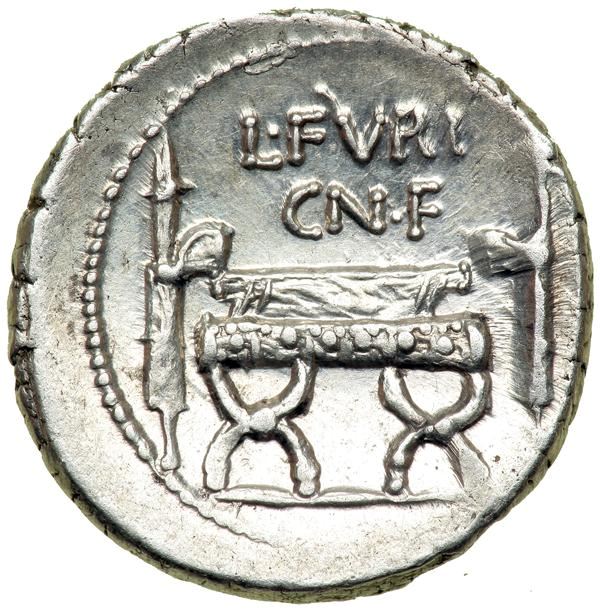
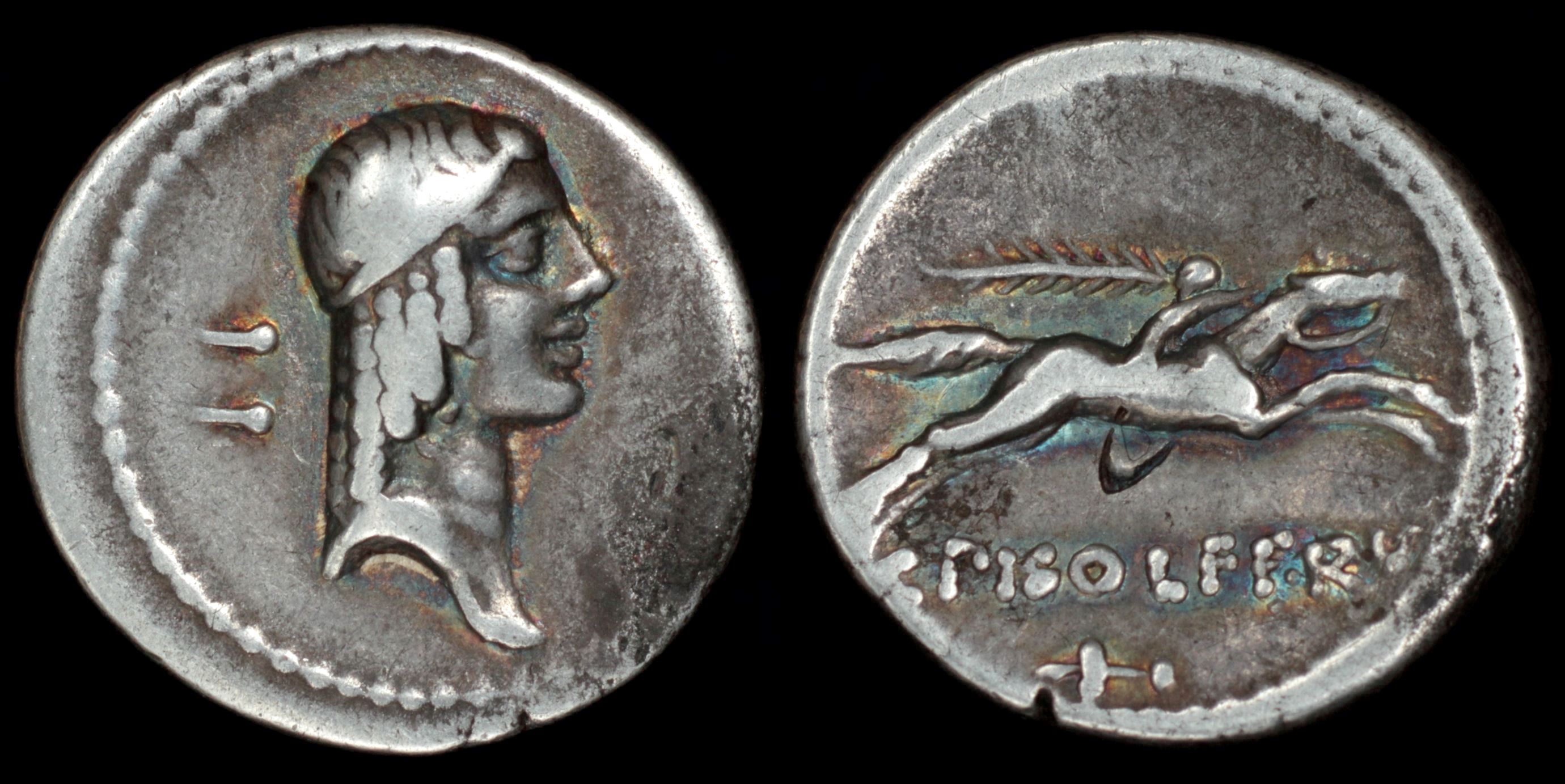
Reverse: naked horseman galloping right, holding palm branch and reins dagger? in exergue, C·PISO L F FRVGI
Die Orientation: -
Weight: 3.9 g
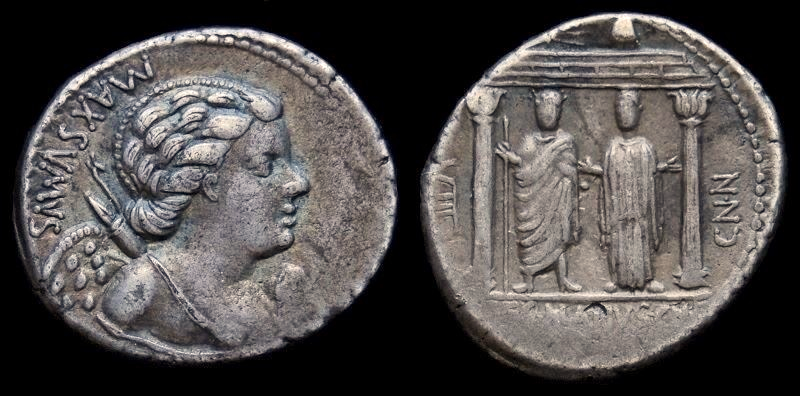
Reverse: Distyle temple with two facing statues within; Jupiter, to the left, holding staff, and Libertas, on the right, holding pileus. Above pediment, thunderbolt and pileus. VIII (control mark) in left field; CN•N in right field; C•EGNATIVS•CN•F in exergue.
Die Orientation: -
Weight: 3.98 g
This moneyer, a man of somewhat disreputable character, was admitted into the Roman senate, but was subsequently expelled by the censors. Not much more is known about him.
In Catullus love poetry, Cupid and Venus are constantly paired as the patrons of all sensual love and they have maintained the same symbolism even today for people who no longer worship the gods. The bust of Cupid so prominently placed on the obverse of Egnatius coin, depicted with his cherub-like features and armed with a bow whose arrows only wound one's heart with passion and desire, but never kill, is symbolic of peace and the pleasure it brings.
This issue is the only surviving record of the Temple of Jupiter Libertas. The temple of Libertas was built on the Aventine hill ca 246 B.C by the plebeian aediles Tiberius Sempronius Gracchus and Gaius Fundanius. The money to finance the erection of the temple came from fines. The main contributor was Claudia, the sister of the consul of 249 B.C, Publius Claudius Pulcher. On an occasion when she found it hard to make her way through the crowded streets of Rome she exclaimed that she wished her brother was still alive to lose another fleet for the Romans for that would thin out the population a little. That insensitive comment cost her 25.000 asses.
In the course of time the temple came to be better known as the temple of Jupiter Libertas. The original connection between the two deities may be found in the belief that Libertas was the daughter of Jupiter and Juno. Egnatius depiction of the temple shows its true bipartite nature at that time. It was restored by Augustus as part of his grand renovation of Rome.”
Provenance: Purchased from Moruzzi Numismatica (5 March 2018). Ex Varesi 63 (26 November 2013), lot 46.
.jpg)
Reverse: Distyle temple with figures of draped Jupiter and Libertas standing facing within; C EGNATIVS CN F below, CN N upwards to right, control numeral (VIII) to left
Die Orientation: 2 H
Weight: 3.96 g
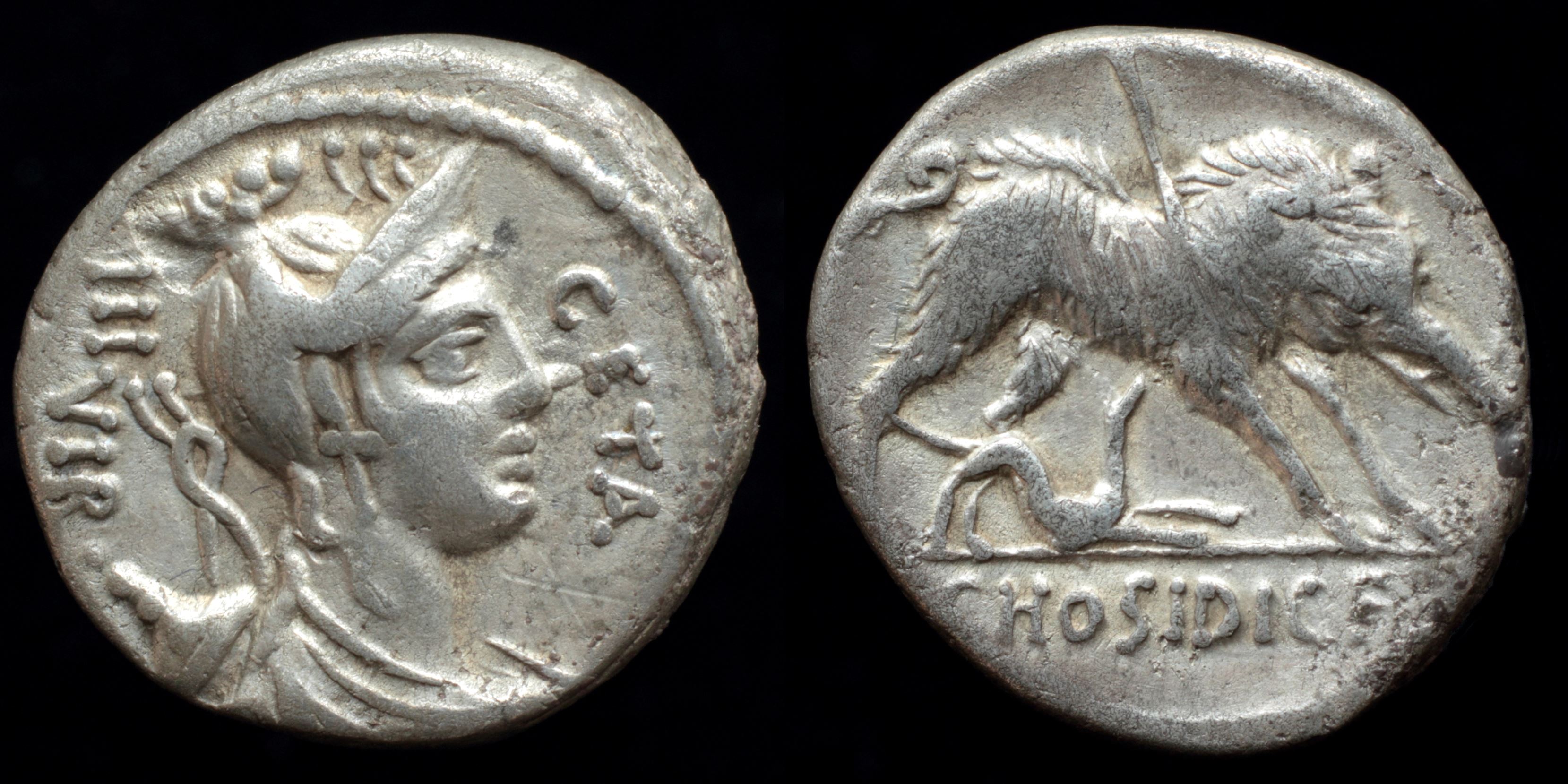
Reverse: attacked boar right, spear in shoulder, hound below, C HOSIDI C F
Die Orientation: -
Weight: 3.6 g
(14).jpg)
Reverse: The Calydonian boar standing right, it’s front legs thrust forward, pierced through by a spear and harried by a hound below; C•HOSIDI•C•F in exergue.
Die Orientation: 6 H
Weight: 3.98 g
_2.jpg)
Reverse: Calydonian boar standing right, pierced by spear and harried by hound below; C HOSIDI C F in exergue
Die Orientation: 6 H
Weight: 3.89 g
Ex. Andrew McCabe Collection (CNG Electronic Auction 472; Lot 259); Ex. Numismatica Ars Classica 114 (Part 2; Lot 1326); Ex. Gorny & Mosch 186 (Lot 1798). Notes from Andrew McCabe: "I purchased this coin due to the really exceptional speared boar and dog on the reverse and the very large flan, but later found an example from the collection of Benjamin Nightingale, a well-known 19th century antiquarian. My new coin has a less cute boar, but I had to choose between provenance and art." Andrew's loss is my gain!
.jpg)
Reverse: Hound running right; spear below, C•POSTVMI and TA monogram in exergue.
Die Orientation: -
Weight: 3.92 g
Provenance: Tauler & Fau Floor Auction 20, (28 November, 2018), lot 112.
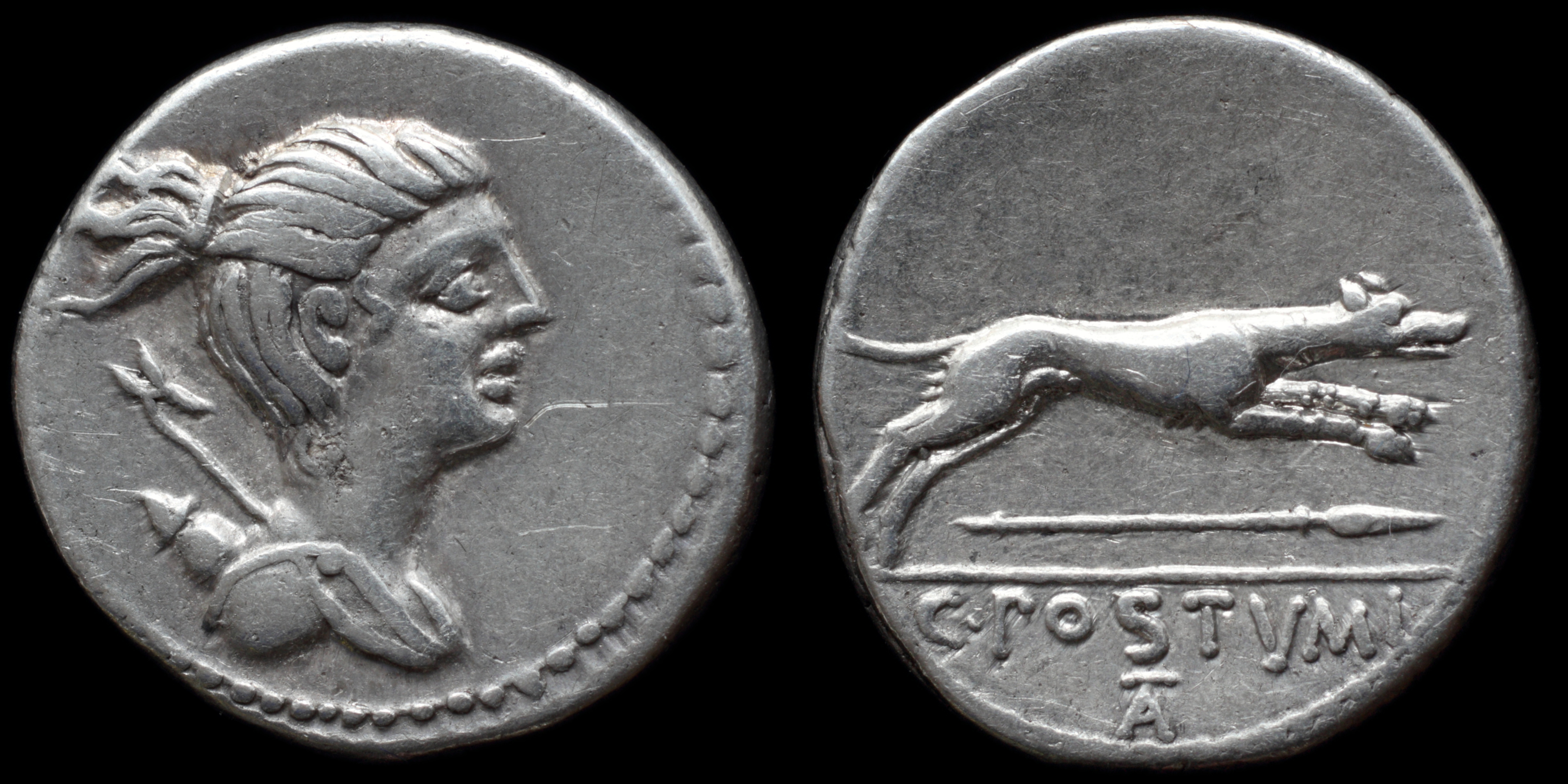
Reverse: hound bounding right, hunting spear below; C·POSTVMI / (TA)
Die Orientation: -
Weight: 4 g
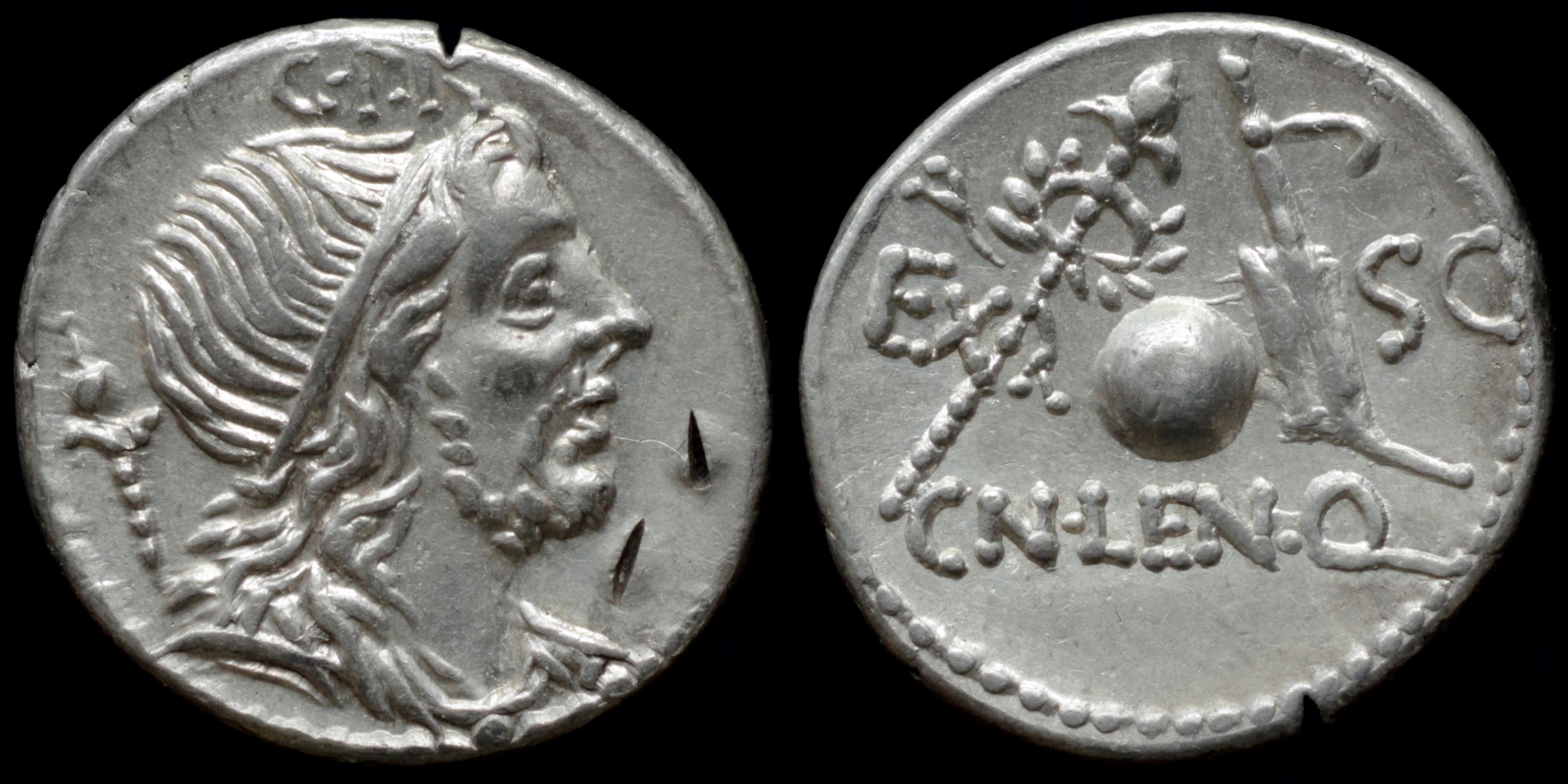
Reverse: wreathed scepter, globe, rudder, EX S·C / CN·LEN·Q
Die Orientation: -
Weight: 3.9 g
mint in Spain. Moneyer struck this coin as questor of proconsul Pompey when he was sent to support Q. Caecilius Metellus Pius in lenghty war against Sertorius in Spain. Moneyer became consul in 56 BC.
Probably struck in late 75 BD in Taras or Brundisium, perhaps the fund of choice to pay local shipping contractors to ferry armies across the Adriatic and back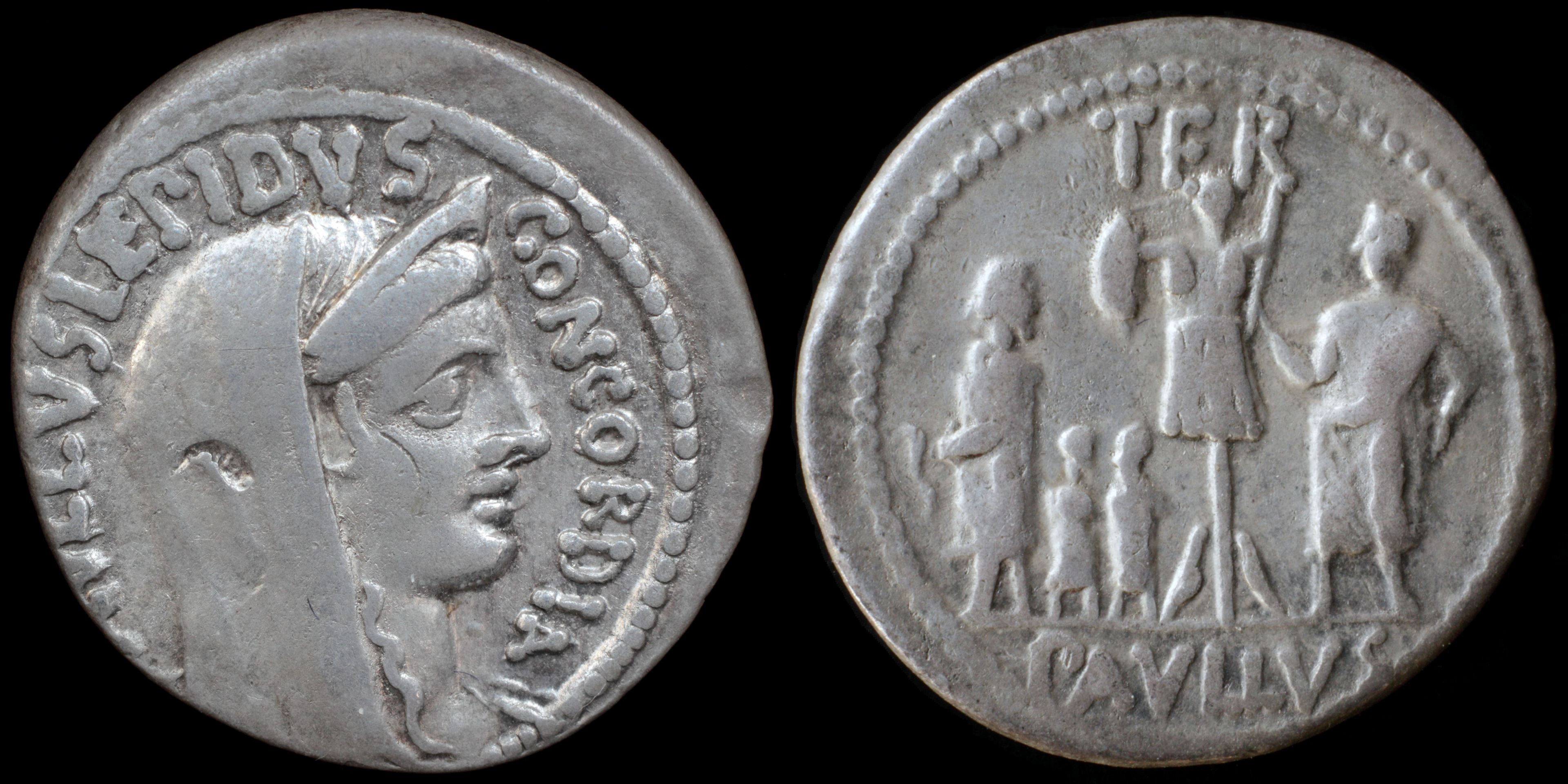
Reverse: L. Aemilius Paullus standing to right of trophy, Perseus and his two sons captive on the left, TER / PAVLLVS
Die Orientation: -
Weight: 3.9 g
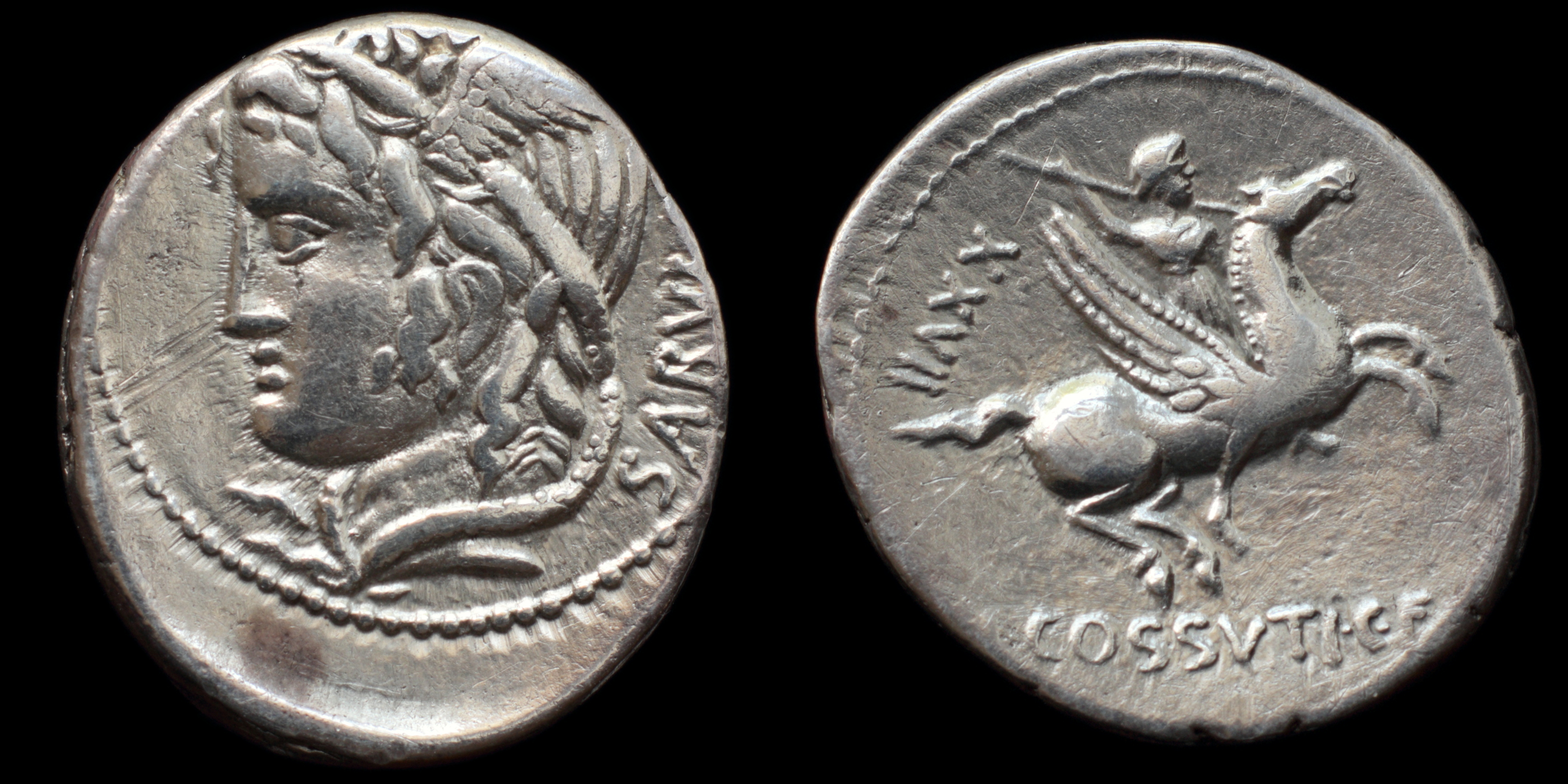
Reverse: Bellerophon on Pegasus right, brandishing spear; XXVII / L·COSSVTI·C·F
Die Orientation: -
Weight: 3.7 g
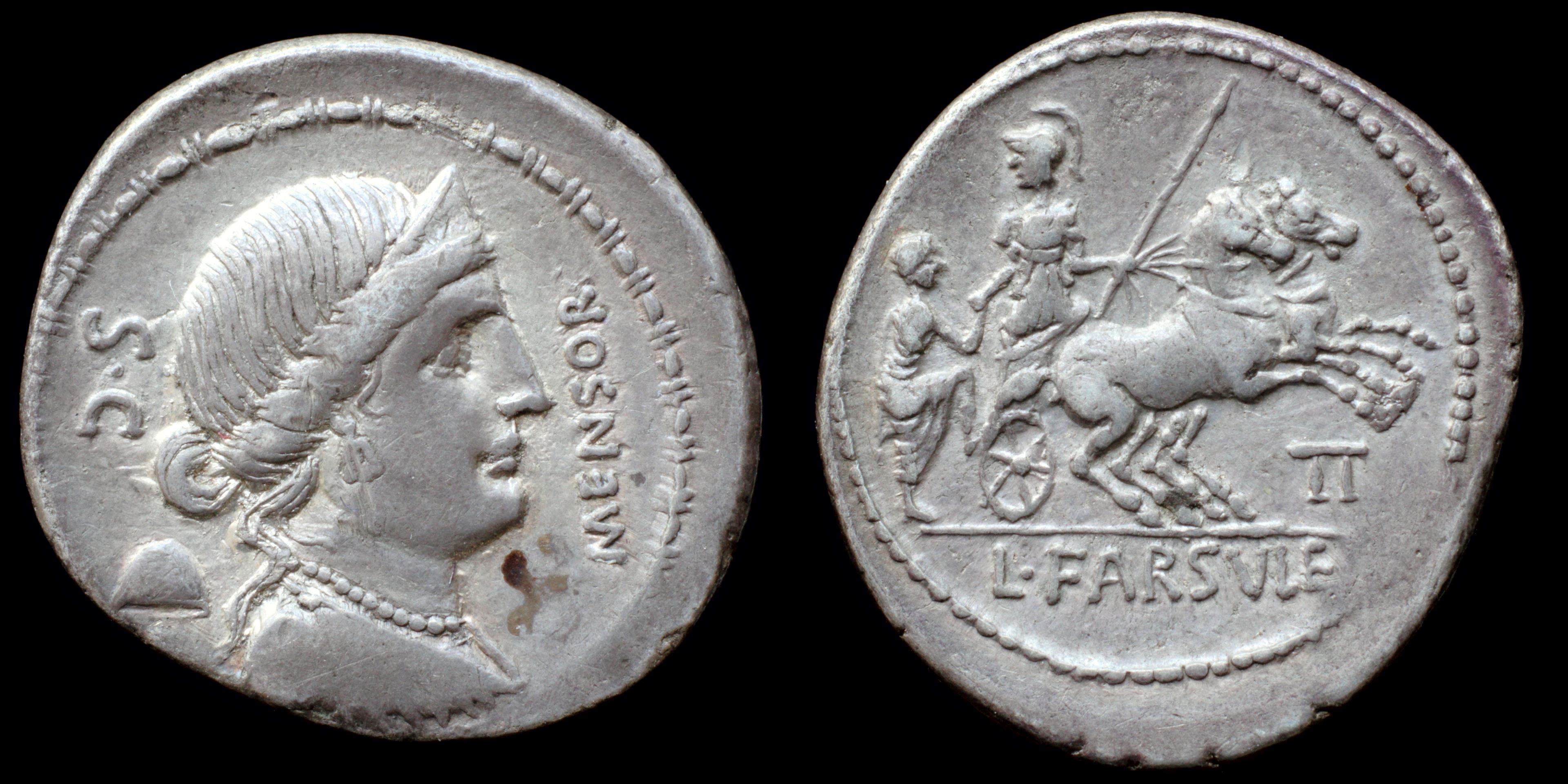
Reverse: helmeted warrior right in biga holding spear and reins asisting citizen togate into biga; II / L·FARSVLEI
Die Orientation: -
Weight: 3.8 g

Reverse: Curule chair between fasces, L•FVRI CN•F above.
Die Orientation: 6 H
Weight: 3.95 g
"Ceres was the Roman goddess of agriculture. She was equivalent to the Greek Demeter. The curule chair (sella curulis) was the official chair of the 'curule' magistracies: the consulship, the praetorship, and the 'curule' aedileship (the two highest aediles). The fasces were bundles of rods bound together. The rods symbolized the power to inflict physical punishment. When an axe (securis) was bound in the middle of the rods, it signified the power to inflict death."
Provenance: CNG 106 (13 September 2017), lot 659.
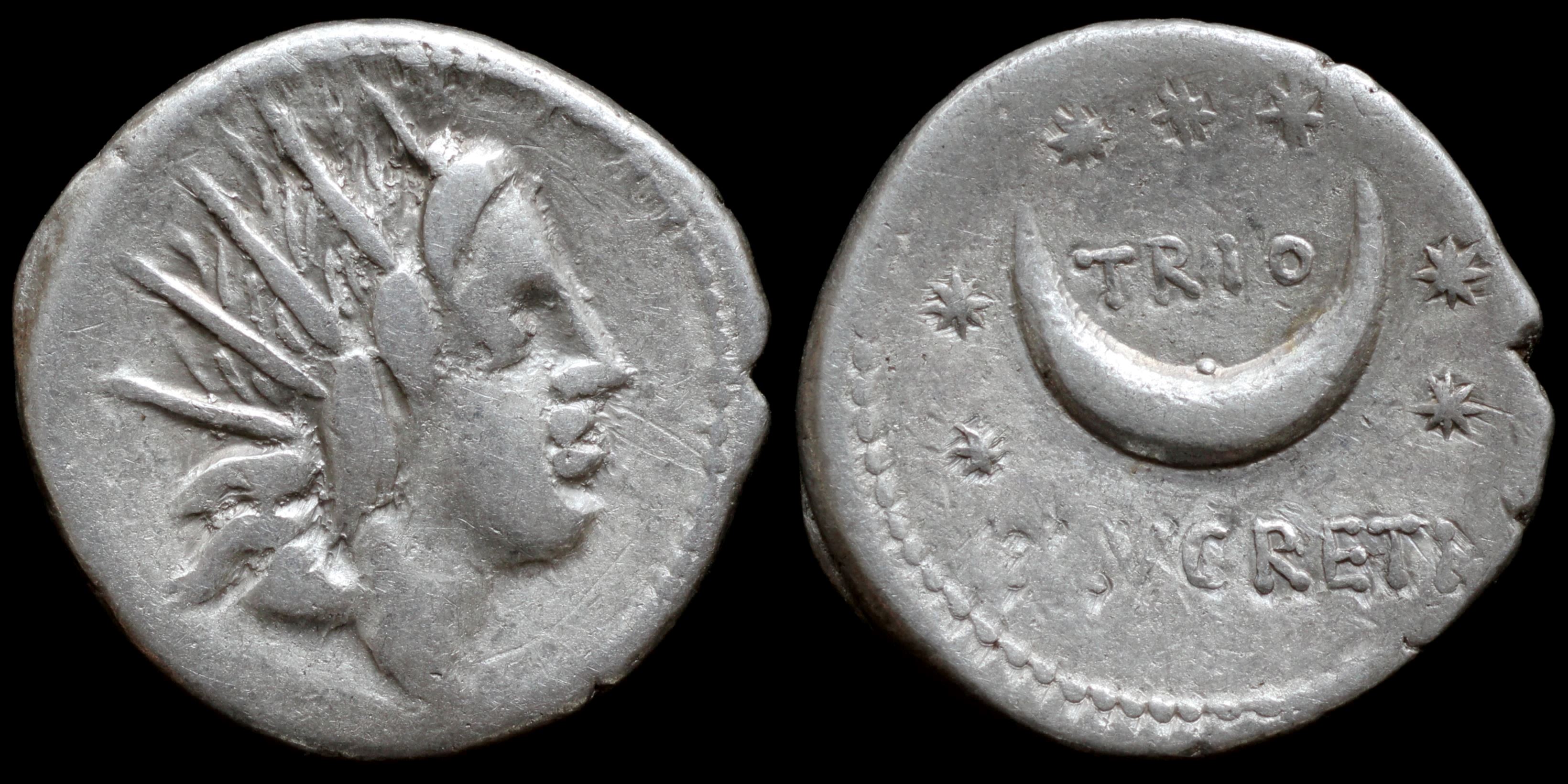
Reverse: crescent moon, 7 stars around - Septem triones (Ursa Major), TRIO / L·LVCRETI
Die Orientation: -
Weight: 4 g
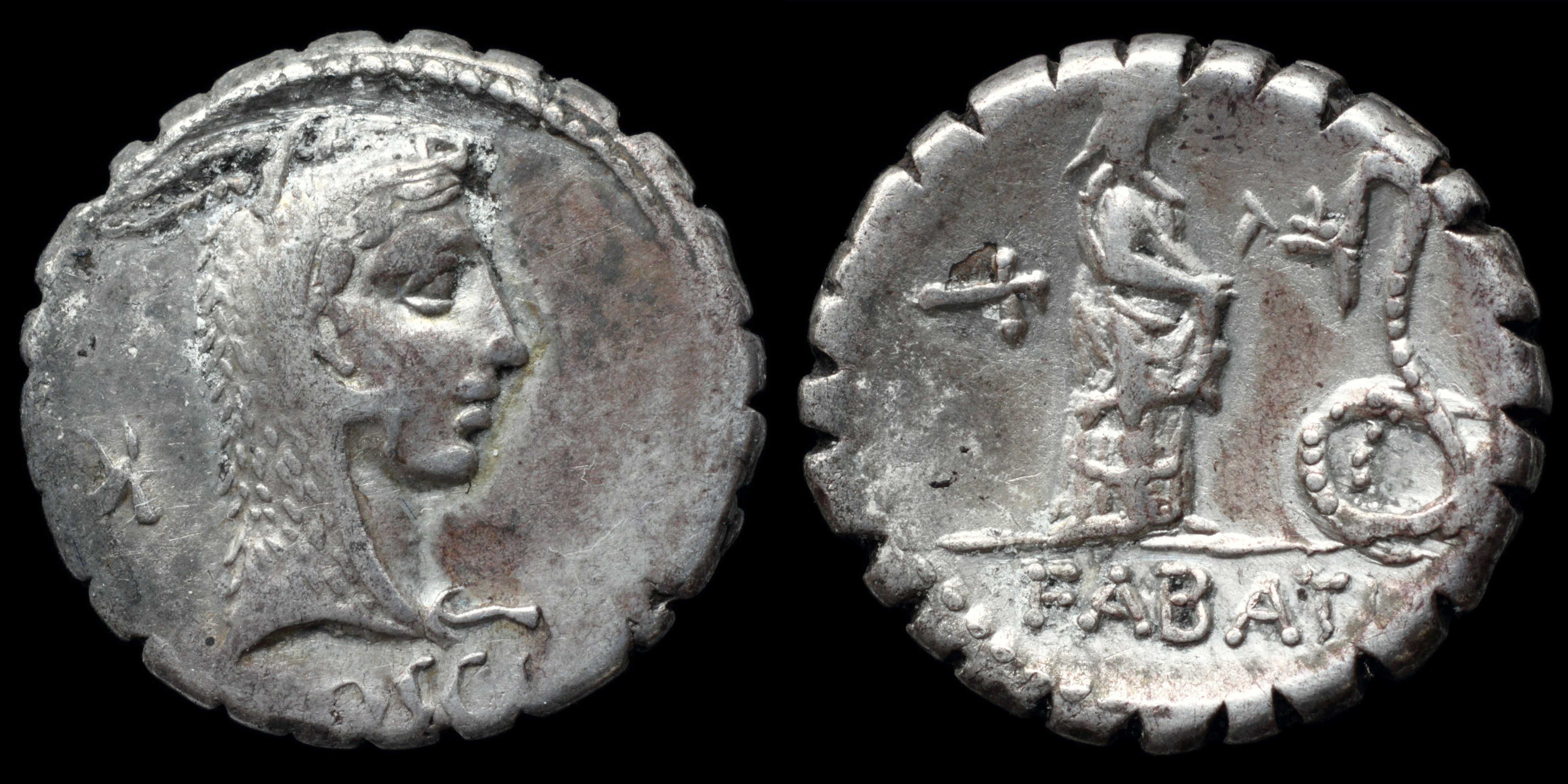
Reverse: maiden standing right, feeding erect serpent; controlmark / FABATI
Die Orientation: -
Weight: 3.8 g
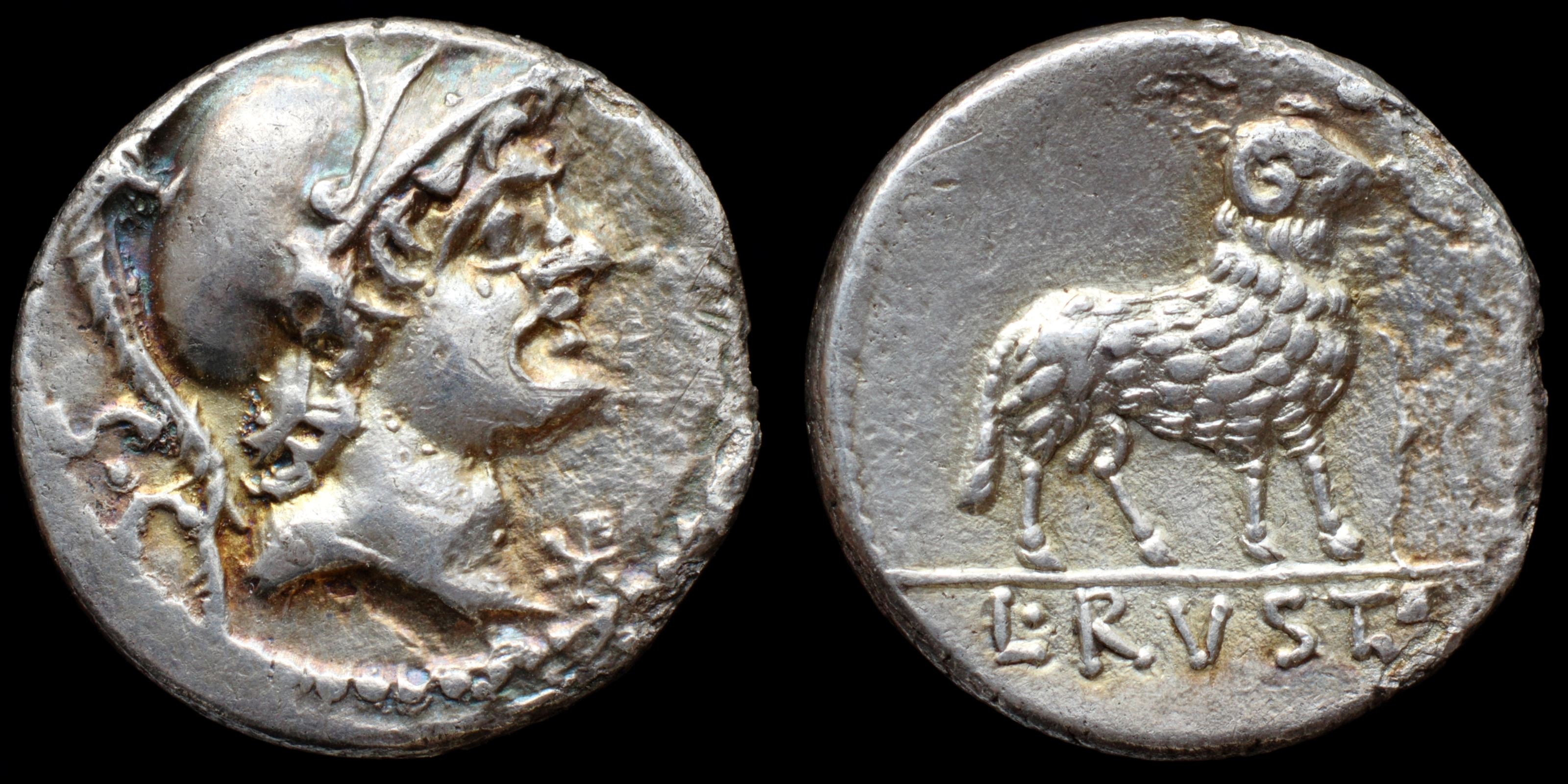
Reverse: ram right; L·RVSTI
Die Orientation: -
Weight: 3.7 g
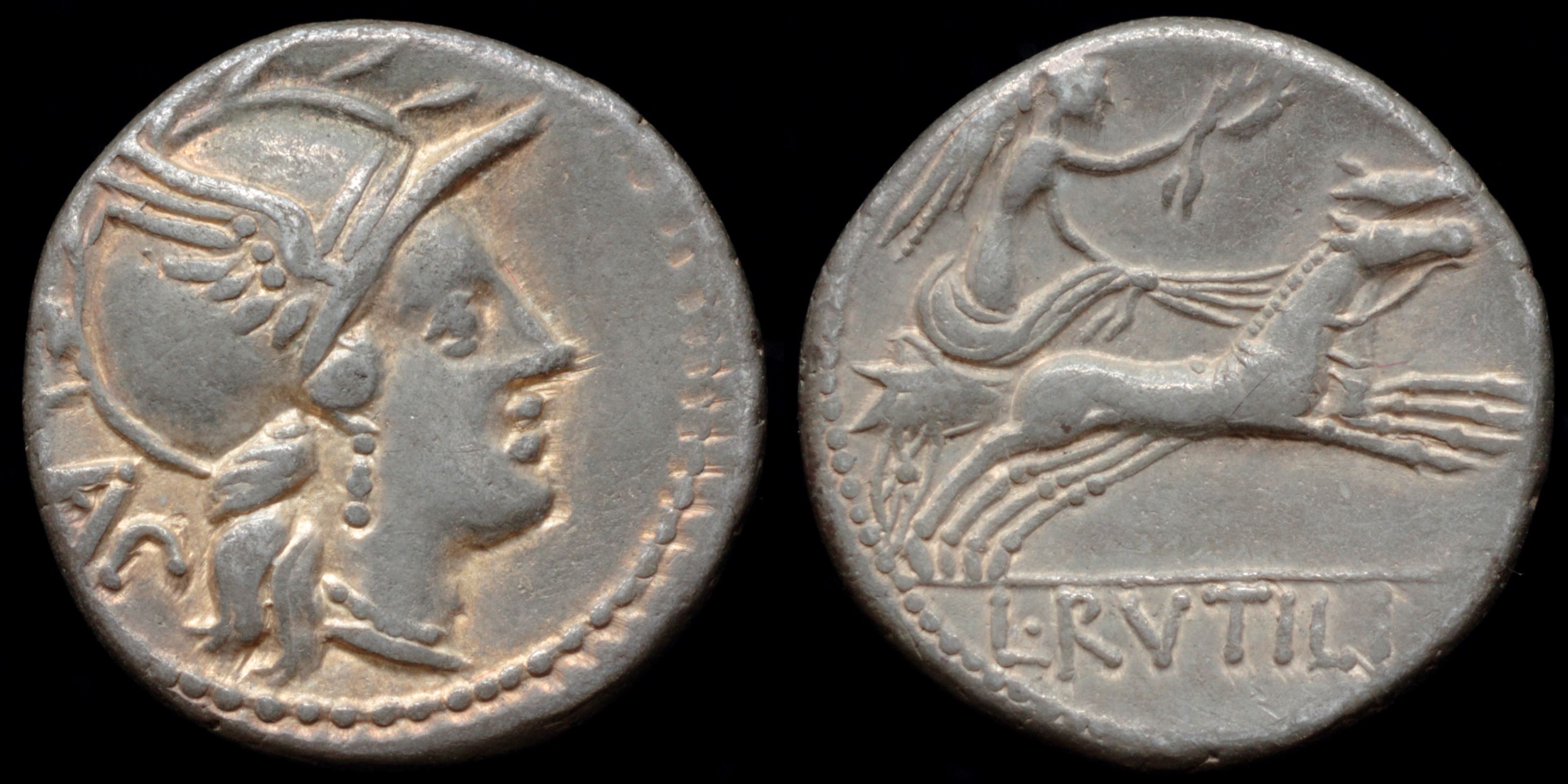
Reverse: Victory in biga right holding wreath and reins, L·RVTILI
Die Orientation: -
Weight: 3.88 g
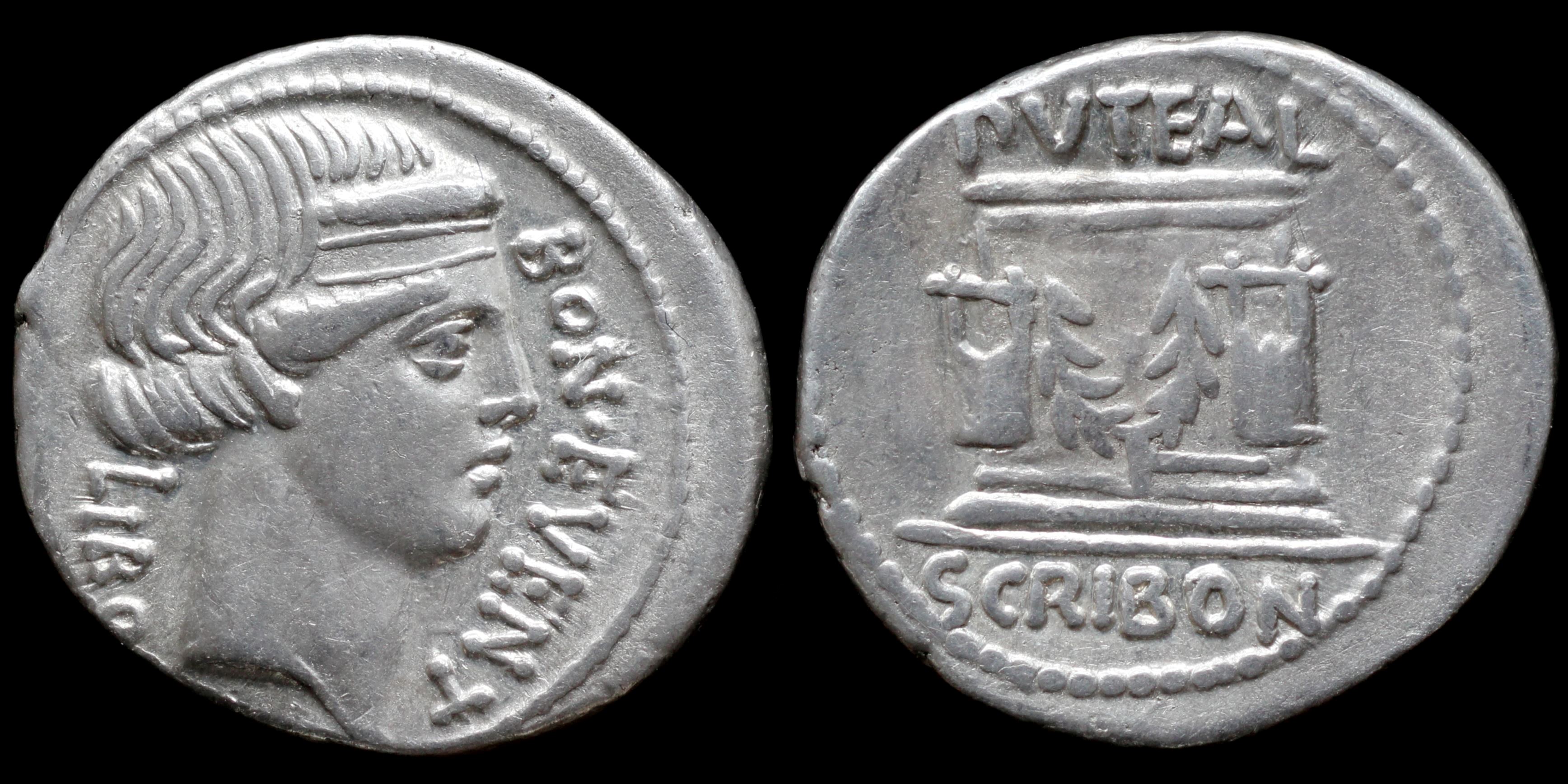
Reverse: Puteal Scribonianum ornamented with garland and two lyres, hammer at base; PVTEAL / SCRIBON
Die Orientation: -
Weight: 4.1 g
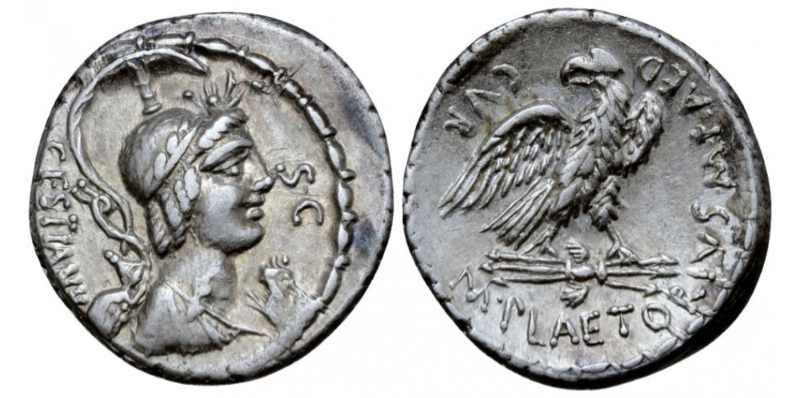
Reverse: Eagle standing right on thunderbolt, head left; M• PLAETORIVS M•F•AED•CVR around
Die Orientation: 7 H
Weight: 3.97 g
.jpg)
Reverse: jug and torch; M·PLAETORI / CEST·S·C
Die Orientation: -
Weight: 4 g
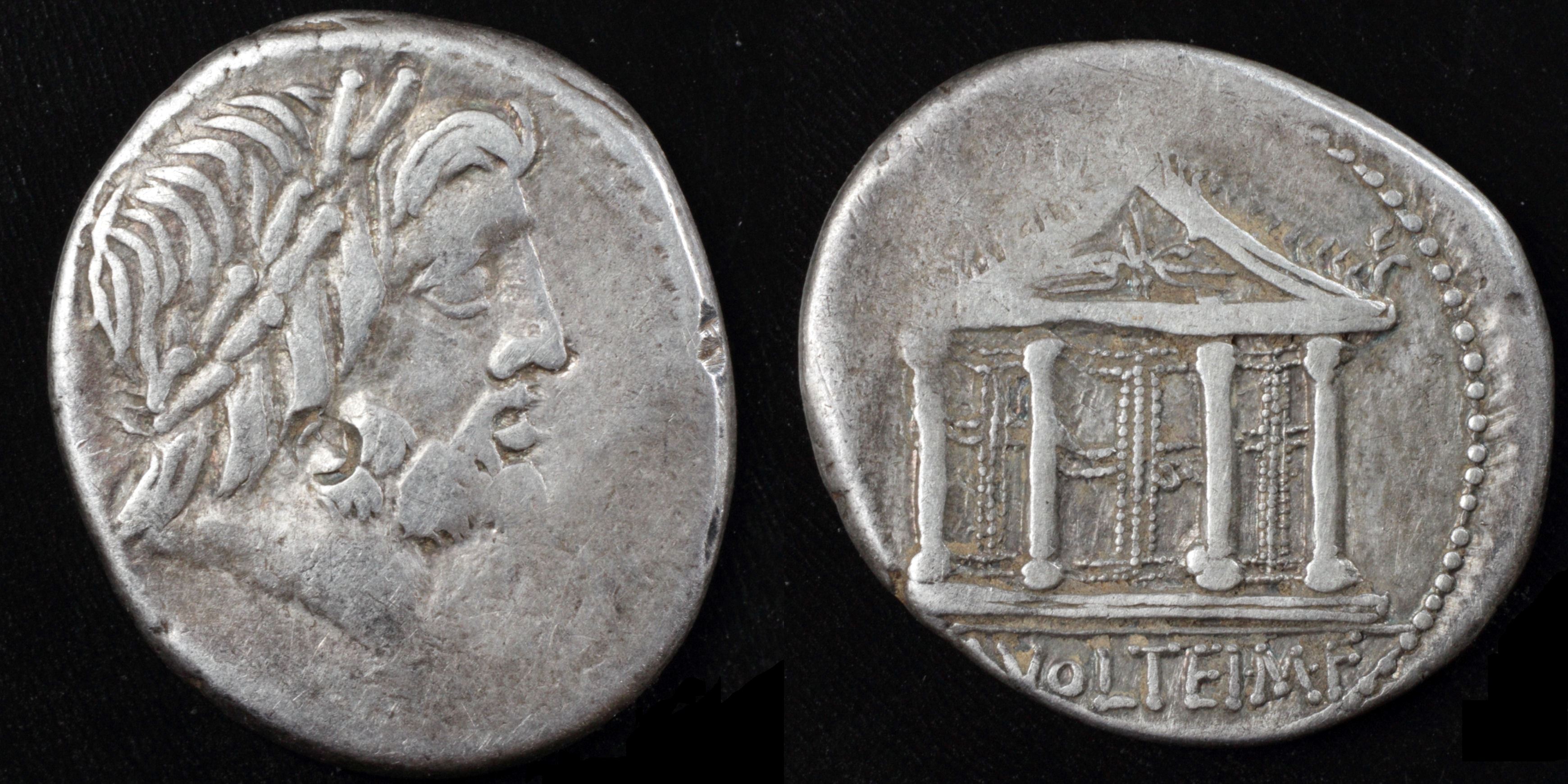
Reverse: tetrastyle temple of Jupiter Capitolinus, thunderbolt in pediment, M·VOLTEI·M·F
Die Orientation: -
Weight: 4.1 g
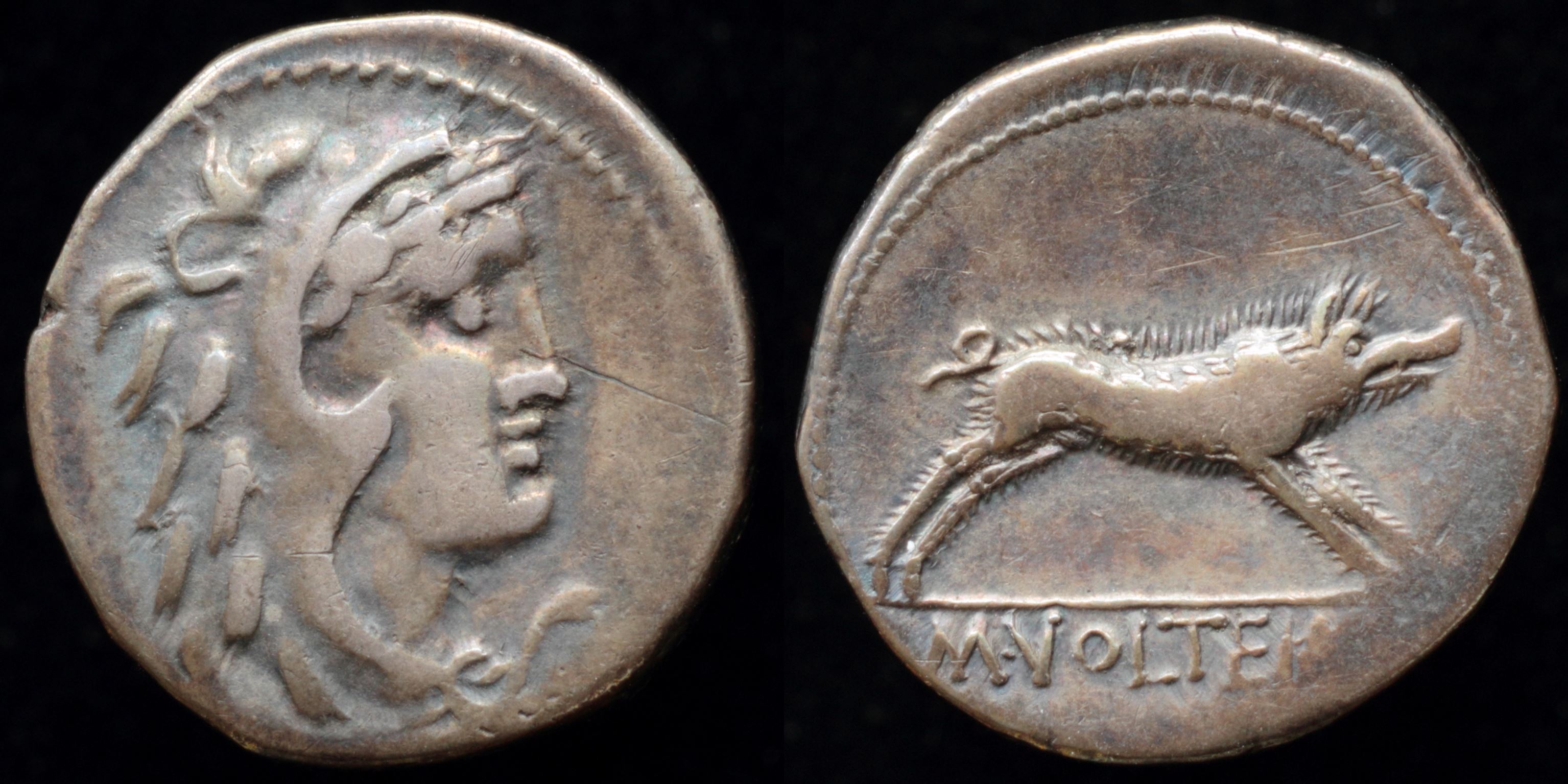
Reverse: Erymanthian Boar right, M·VOLTEI·M·F
Die Orientation: -
Weight: 4.1 g
(2).jpg)
Reverse: Cybele seated in biga of lions right; O above, M VOLTEI M F in exergue
Die Orientation: 6 H
Weight: 3.89 g
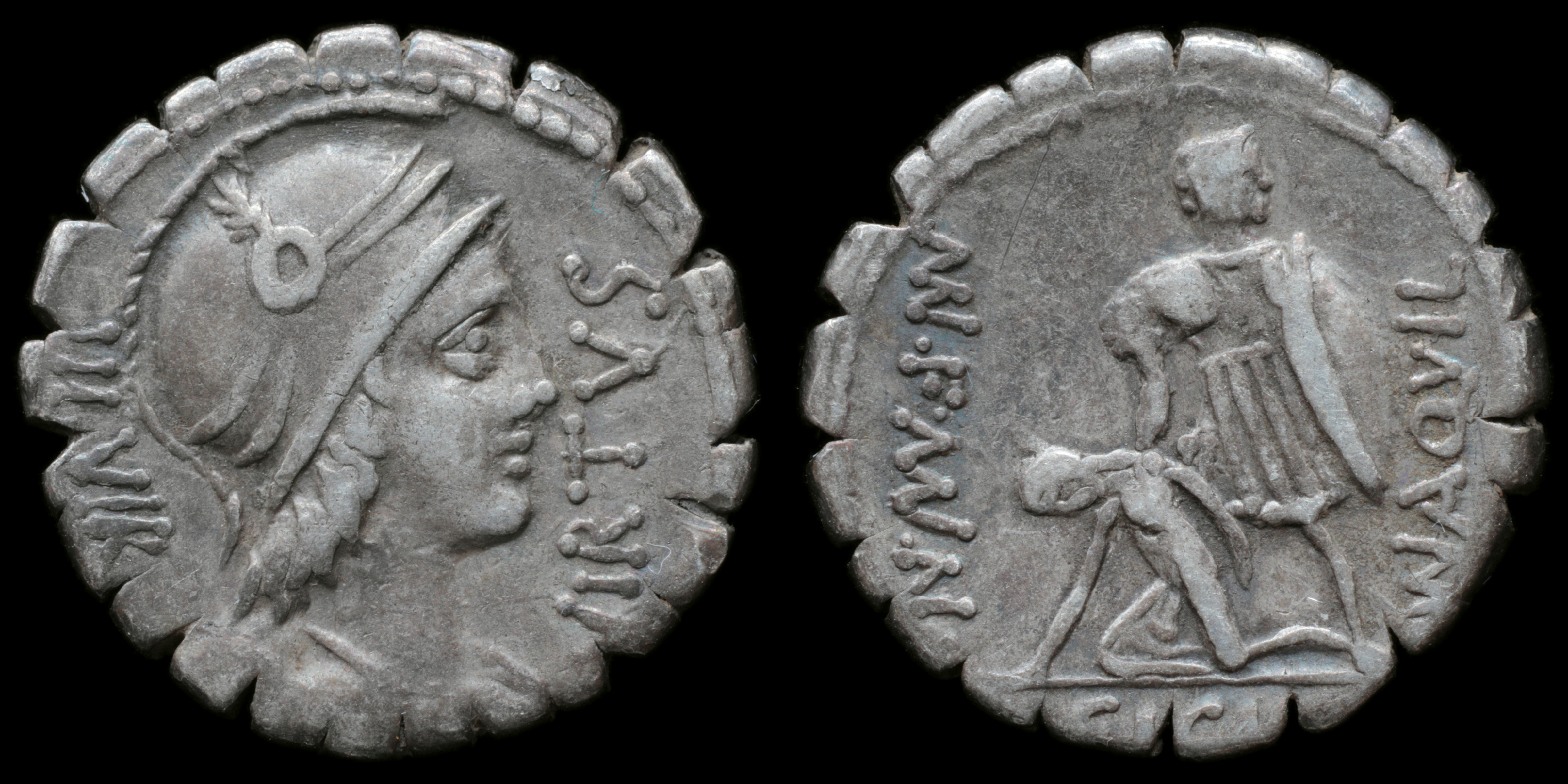
Reverse: Mn. Aquillius (consul 101 BC) facing, head right, holding shield, raising kneeling and slumped Sicilia left; (MN) AQVIL__(MN)·F·(MN)·N· / SICIL
Die Orientation: -
Weight: 3.9 g
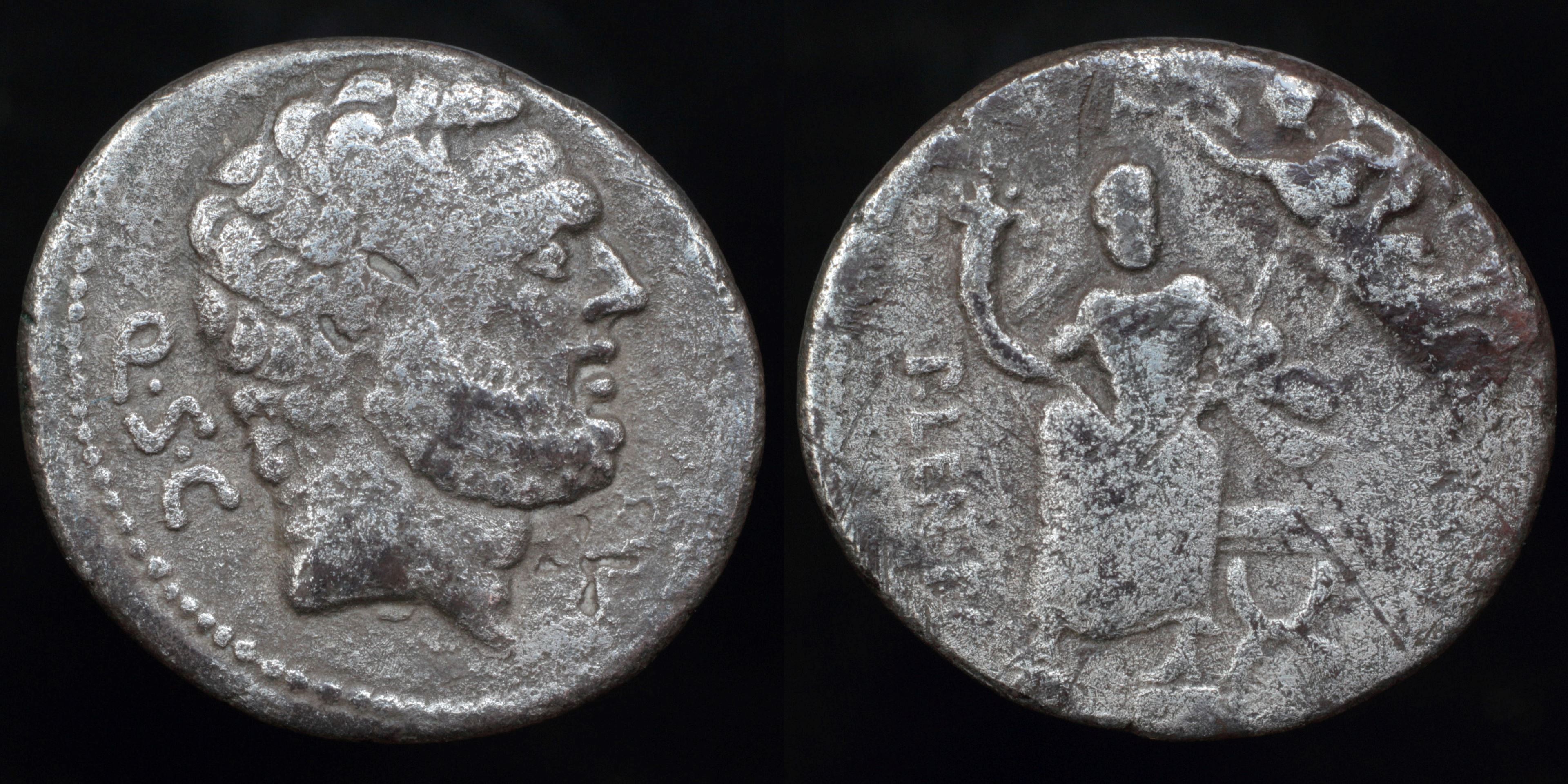
Reverse: Genius Populi Romani facing, seated on curule chair, with right foot on globe, holding cornucopia and scepter; Victory flying and crowning Genius, holding wreath and palm, P·LENT·P·F L·N
Die Orientation: -
Weight: 3.4 g
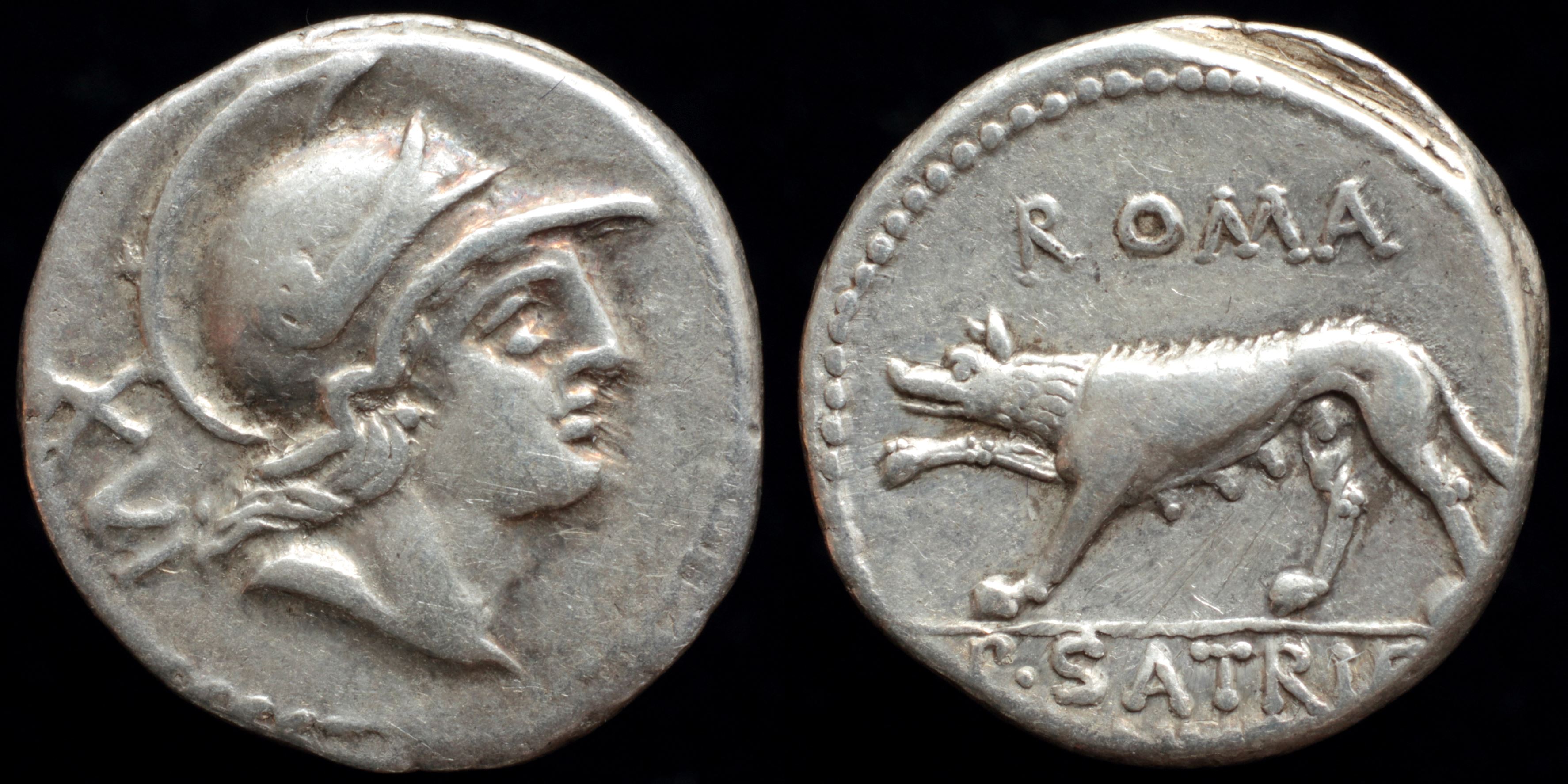
Reverse: she-wolf prowling left, ROMA / P. SATRIE / NVS
Die Orientation: -
Weight: 3.9 g

Reverse: Erato, the Muse of Erotic Poetry, standing slightly right, habited in the stola — over which is the palla, — holding a kithara, and playing upon it with a simple plectrum held at her side; Q•POMPONI to left; MVSA to right.
Die Orientation: -
Weight: 3.98 g
The Muses are the inspirational goddesses of literature, science, and the arts in Greek mythology. They were considered the source of the knowledge embodied in the poetry, lyric songs, and myths that were related orally for centuries in these ancient cultures. They were later adopted by the Romans as a part of their pantheon. According to Hesiod's Theogony from the seventh century BC, they were daughters of Zeus, king of the gods, and Mnemosyne, Titan goddess of memory. For Alcman and Mimnermus, they were even more primordial, springing from the early deities Ouranos and Gaia. Gaia is Mother Earth, an early mother goddess who was worshipped at Delphi from prehistoric times, long before the site was rededicated to Apollo, possibly indicating a transfer to association with him after that time.
Sometimes the Muses are referred to as water nymphs, associated with the springs of Helicon and with Pieris. It was said that the winged horse Pegasus touched his hooves to the ground on Helicon, causing four sacred springs to burst forth, from which the Muses were born. Athena later tamed the horse and presented him to the Muses.
Classical writers set Apollo as their leader. In one myth, the Muses judged a contest between Apollo and Marsyas. They also gathered the pieces of the dead body of Orpheus, son of Calliope, and buried them in Leivithra. In a later myth, Thamyris challenged them to a singing contest. They won and punished Thamyris by blinding him and robbing him of his singing ability. The earliest known records of the Nine Muses are from Boeotia, the homeland of Hesiod.
It was not until Hellenistic times that the following systematic set of functions was assigned to them, and even then there was some variation in both their names and their attributes: Calliope (epic poetry), Clio (history), Euterpe (flutes and lyric poetry), Thalia (comedy and pastoral poetry), Melpomene (tragedy), Terpsichore (dance), Erato (erotic/love poetry), Polyhymnia (sacred poetry), Urania (astronomy).
Erato was one of the nine Muses. In the Classical era, when the Muses were assigned specific literary and artistic spheres, Erato was named Muse of erotic poetry and mime, and represented with a kithara. Her name means "lovely" or "desired" from the Greek word eratos."
Provenance: Purchased from Moruzzi Numismatica (25 April 2018).

Reverse: Urania, the Muse of Astronomy, wearing long flowing tunic and peplum, standing left, touching with wand held in right hand a globe set on base; Q • POMPONI downward to right, MVSA downward to left.
Die Orientation: -
Weight: 18.5 g
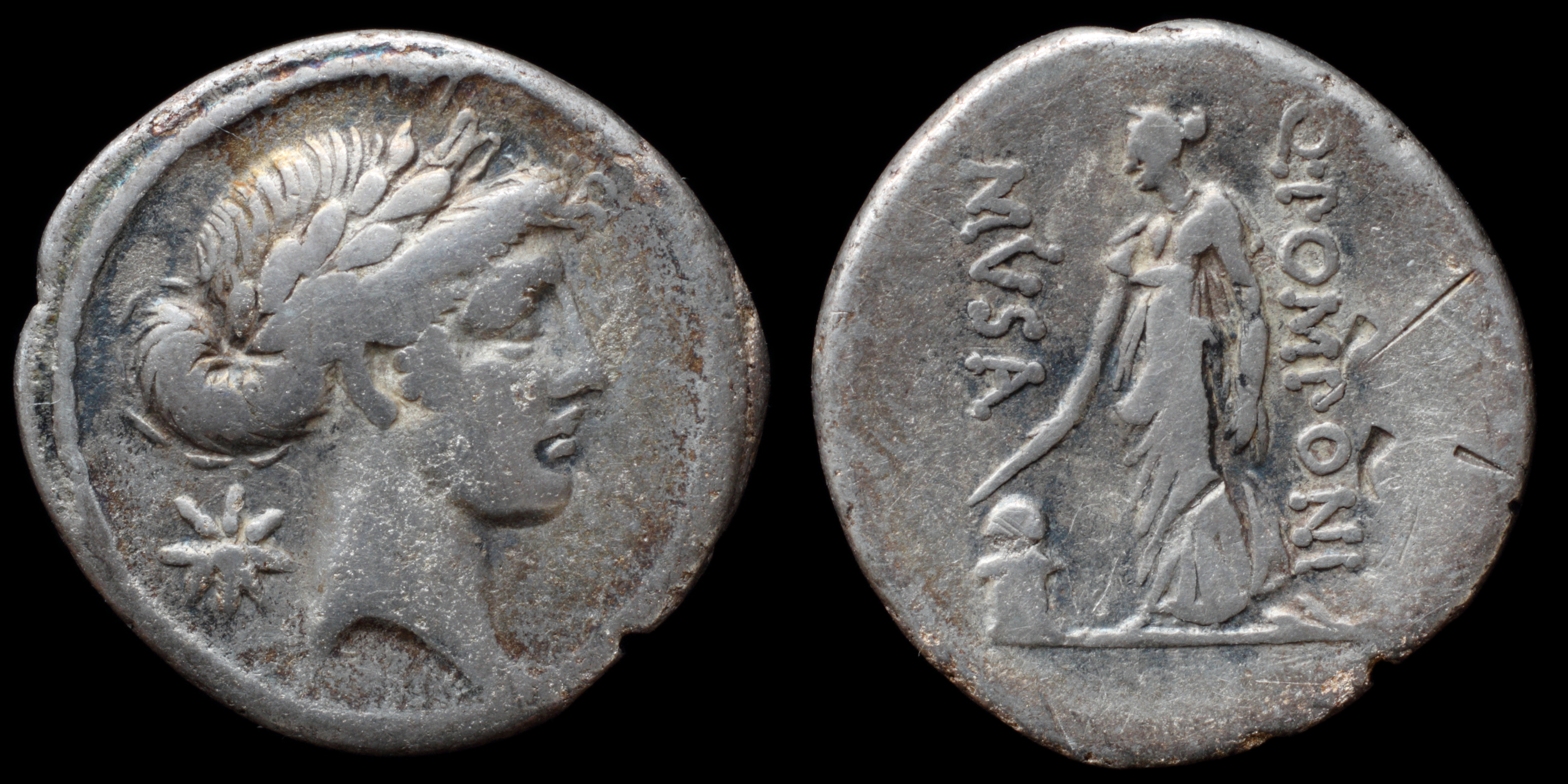
Reverse: Urania, Muse of Astronomy standing left, pointing with rod in right hand at globe on tripod-stand; Q·POMPONI // MVSA
Die Orientation: -
Weight: 3.8 g
